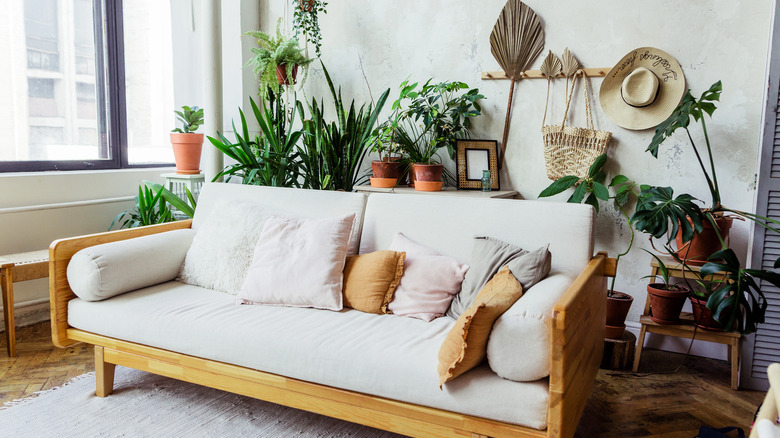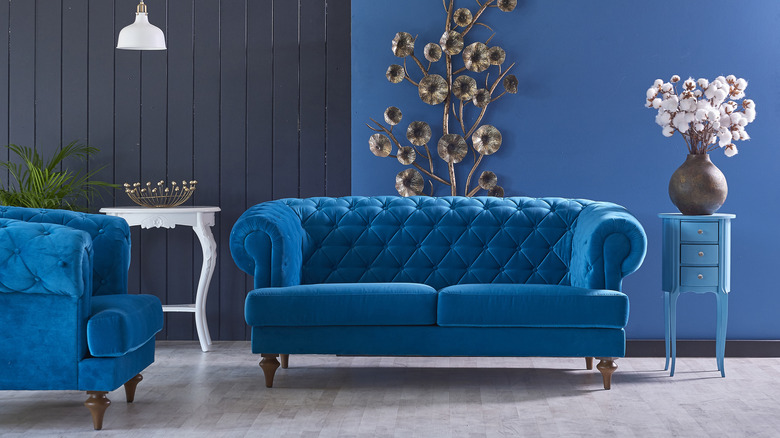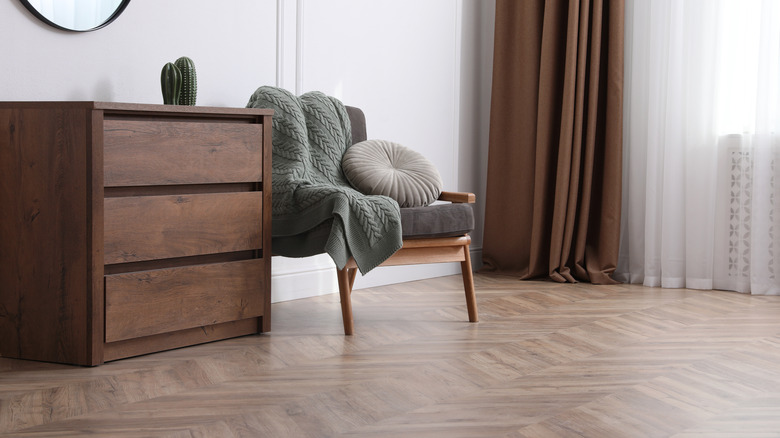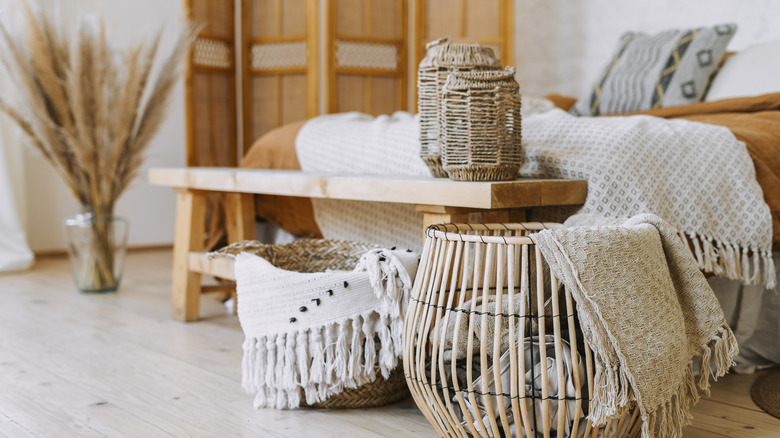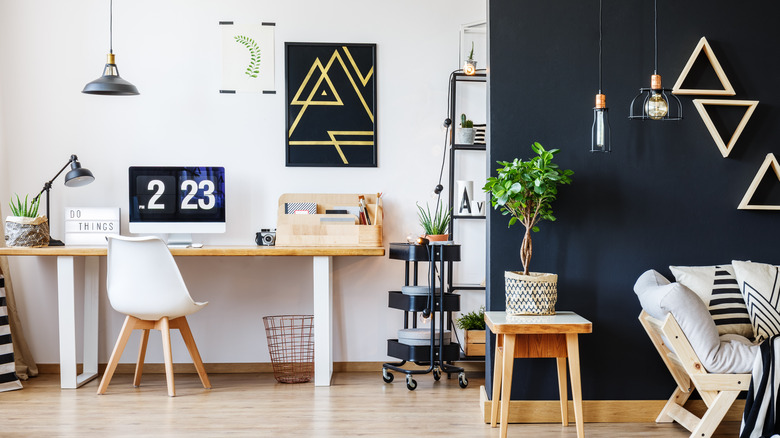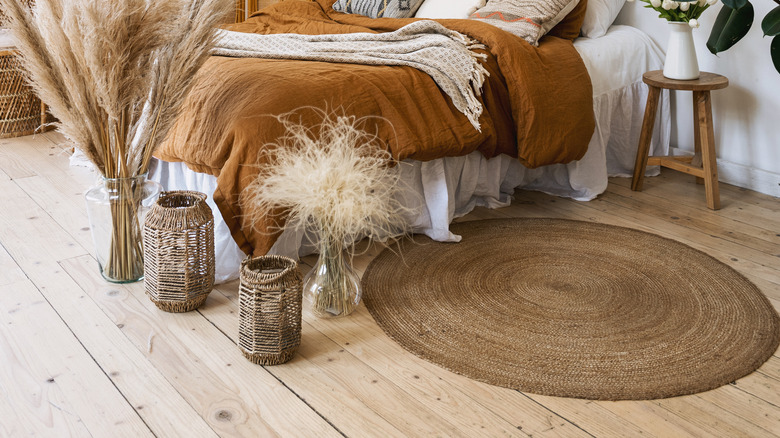The Best Environmentally-Savvy Décor Items For Your Home
For years, environmentally conscious shoppers have transformed their closets into sustainable collections to protect the planet and its inhabitants. Buying clothes from designers who promote this idea isn't the only way to be more environmentally savvy, though. Your home décor can also get an eco-friendly makeover, boasting an interior design that is planet-friendly and beneficial to the cause. According to The Zoe Report, one of the most significant changes you can make to redirect towards a sustainable home is to purchase items with staying power. For example, invest in furniture that will last, rather than pieces that need to be replaced more often.
Changing everything from the type of paint you buy to the linens you decorate with all contribute to going green within your space. It might take time to adjust to environmentally-forward thinking, especially because many stores want to help homeowners decorate on a budget. Sustainable products aren't always the least expensive options, but you might be surprised to find they aren't the most expensive. The following décor tips can help you go green with your interior design while maintaining your personal style and preferences.
Upcycled and reupholstered furniture
When it comes to craving a change, you might look at your old couch, chair, or table and think you're ready for a new look. While this is refreshing and alters the aesthetic of your home quickly, it is the opposite of sustainability, especially if the pieces you buy or replace will have to be swapped out again in a few months or years. The environmentally-savvy décor is all about avoiding excess and saving materials rather than continually buying them. Instead of replacing an item completely, think about upcycling.
According to The Zoe Report, reupholstering is a great way to breathe new life into a furniture piece. You can choose from eco-friendly fabrics or something that just suits your tastes. Because you aren't throwing the entire couch away, you can treat yourself to that plush velvet material that will make it look like you broke the bank on a whole new piece. Even if the fabric isn't necessarily green, you are still acting in a sustainable way by reupholstering an item. Of course, aiming for eco-friendly fabrics is always a bonus, but as long as you aren't throwing furniture away constantly, your home is already on its way to becoming more green.
Thrifted items
You might have one or two thrift store items hanging around your house, but did you know this is a form of sustainable décor? Buying second-hand is a great way to help out the planet because you are reusing something rather than throwing it away. While thrift stores can be tricky to navigate, it is possible to find some incredible items if you know what you're looking for.
According to The Zoe Report, seeking furniture or other pieces in a flea market or thrift store allows you to source things sustainably, all while investing in an eco-friendly lifestyle. While the saying "One man's trash is another man's treasure" might sound too ambiguous, the truth is that these second-hand stores boast a variety of treasures. Someone may have let an old table or armoire go because it no longer fit their needs, but that doesn't mean there is anything undesirable about it.
The main thing to consider when shopping in thrift stores is if a piece is salvageable. You don't want to spend money on something that will fall apart as soon as you get it home. Do a good once over before leaving the store or market, and assess any damage or weak spots. Often, pieces from a thrift shop can be fixed, upcycled, or modified to suit people's needs. They only need a little TLC and a motivated mind.
Sustainable fabrics
Fabrics are a big part of a sustainable lifestyle. Like with clothing, choosing bedding, throws, fabrics, and towels that are made from eco-friendly materials will change the way you live. When looking for new items to decorate with, aim for fabrics that have been dubbed sustainable or eco-friendly, like organic or recycled cotton. Sustainable Jungle has a list of environmentally-savvy materials that homeowners can reference when shopping, ranging from organic bamboo to sustainably sourced wool.
Organic cotton is farmed in a much more ethical way than regular cotton, using fewer pesticides and chemicals, as well as less water and energy all around. According to Sustainable Jungle, organic hemp is another material perfect for anyone looking to go green because it pulls CO2 out of the atmosphere. Finally, bamboo linen doesn't require the whole plant to be harvested, which allows it to self-renew quickly and efficiently. This type of linen looks great in any home, and you'll feel even better every time you use any of these options because they don't add harmful elements to the environment.
Non-toxic paint and wallpaper
Switching up certain household supplies can also help make your home more eco-friendly while still bringing in an aesthetically pleasing element. For example, using non-toxic paint to coat your walls will ensure less harmful chemicals are released into the air, all while giving your space a fresh look. Eco-friendly paints don't have gases or chemicals that create airborne effects, which are bad for the environment and people's health. The Ethical Home Edit recommends looking for options that are free from VOCs or volatile organic compounds, as well as fumes that can be considered harmful.
You can also invest in wallpaper that is non-toxic, giving a room or space a whole new appearance without any of the accompanying hazards. It might come as a surprise that wallpapers contain toxins, but many do (via Gimme the Good Stuff). Choosing peel and stick options that come without VOCs is better for everyone inside the home, as well as visitors, pets, plants, and any other living things. One of the perks of peel-and-stick wallpaper is that it offers the ease of a fresh start without long renovations or additions. Incorporating non-toxic paints and wallpapers is a great way to make your home more eco-friendly.
Sustainable and eco-friendly adornments
Rugs are a great statement piece or filler for any home, but many actually contain harmful substances that are bad for the environment. Dyes, chemicals, and glues are all used to help rugs maintain their shape and deflect water or stains, which end up making them detrimental to the planet. Not only are you around these substances every day but making them creates negative results for the environment. You can still have an aesthetically charged space, complete with a luxurious rug, without damaging your home, health, and happiness.
Invest in a non-toxic rug for your living space by choosing the material wisely. Pick wool, organic cotton, or jute for the fiber base, as these are all sustainable options and better for the planet. The back of your rug can be just as harmful as the front, so check what the padding is made of on the underlay before purchasing. The Good Trade recommends sticking to natural latex, or jute, which is basically a vegetable fiber that is long and skinny, making it ideal for creating coarse, lengthy threads. Whenever you're buying furniture, fabrics, or décor, check the source they came from or stick to local artisans that use sustainable methods to produce their items. This way, you'll know your home is eco-friendly and environmentally savvy.

